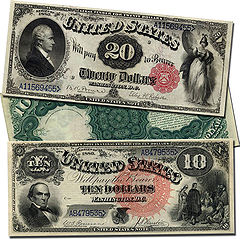 |
| US Notes – aka Greenbacks Wiki image |
Anthony Migchels
Activist Post
The Greenback was the Dollar, or United States Note, printed by Abraham Lincoln’s Treasury to finance the Civil War.
It was a paper dollar, debt free and, therefore, also interest free. It was spent into circulation by the U.S. Treasury department beginning in 1862. Although modified many times through legislation, U.S. Notes were printed until 1971. Even today a minute number of Greenbacks are still in circulation.
Debt-free paper money was the basic design for most early government currencies as usury was heavily frowned upon. The Continental was similar, as was the paper printed by the Chinese Emperors. In this essay we will use the term Greenback to describe this basic model.
The Greenback is both much maligned and much admired.
The Libertarians and Austrian Economists are concerned with the inflation that the Greenback brings. They rightly point out that every debt-free government currency has inflated itself into extinction. This is their primary motivation for demanding a gold standard to hedge inflation.
 |
| Advertisement |
Populists and others praise the fact that it’s debt free (interest free), which clearly is a great boon to society, as it stops the interest drain to the plutocracy.
Money supplies operated by government are usually prone to long term inflation, which can often be quite severe.
Currencies operated by the Banking Fraternity (today’s Dollar, Yen and Euro, etc) are usually characterized by boom/bust cycles, also known as the business cycle.
When governments can print their own cash and spend it into circulation, they clearly have a great incentive to inflate the money supply. They basically have a free lunch, spending the newly printed dollars at full value, after which the population pays when prices rise as a result of these new dollars.
Besides the hidden inflation tax, when they do this, it results in more actual taxes. Taxes must be raised by governments to maintain the higher cost of operating public services due to inflation and increased spending.
Therefore, inflation does not hinder, but actually facilitates nominal economic growth. This appears to be beneficial to both the population at large and the government because the GDP is artificially inflated.
The Central Banking Fraternity usually creates the business cycle; first inflation, then deflation, inflation again etc. During the days of gold-backed currencies which operated in modern Europe up to the thirties of the last century, the norm was deflation, alternated by asset bubbles. Since the Second World War and especially after 1972, they dropped their peg to gold and operated a debt-based paper currency. Inflation was then the norm, alternated by deflationary depressions.
Most importantly, banking currencies are now always interest bearing. For every unit in circulation, interest must be paid. This should hinder the velocity of money circulation and is ultimately deflationary, thus hindering economic growth.
However, governments could of course create some interest-free credit for itself. But this would also add to the inflationary pressures, because it would probably give itself far more credit than it could pay off — as we have seen in recent times but with interest attached.
There is another major limitation to the Greenback: it still needs banks for credit. Savers are needed to capitalize those banks, both in a full reserve or fractional reserve environment. Those banks will operate with interest, preserving at least some of the drain to big banks, but eliminating the blood-sucking of the central banking cartels. Interest-free mortgages will not be available. Additionally, savers could also be very vulnerable with an inflationary Greenback.
Also there is the point that it is very easy to get debt-free money in circulation (just print and spend), but it’s very difficult to get them out of circulation. Credit-based currencies are taken out of circulation when debts are repaid, but debt-free money must be taxed and then not spent again to discontinue circulation. This is not the kind of discipline governments are known for.
There is yet another important point to be made: governments preside over too large of regions to manage currencies properly.
A perfect example is the Euro. It is now well known that the Euro’s one-size-fits-all monetary policy is disastrous for all parties. There is a structural imbalance in competitiveness. Germany and its satellites are great exporters, and therefore importing tens of billions of euros annually from less-productive economies in Euroland. This results in deflationary pressures in these less competitive regions. This brings strong pressures to these nations to either adapt, or to suffer.
But what for? Must a Spaniard be as thrifty as a German? They enjoy a more pleasant climate and may have other priorities. It is the collectivists in Brussels and Frankfurt deciding for them through monetary policy. If a country no longer determines its own tax and spend policies, what sovereignty do they really have?
This is the same everywhere. The United States has known one basic monetary unit ever since their independence. Because regions like Arkansas, Montana etc are less competitive, relatively few dollars circulate there. As a result there is not sufficient capital to allow full employment.
This problem exists even in small countries. For instance The Netherlands, which has been one of the richest countries in the world ever since the days of the Amsterdam Empire. But the Dutch economy is to this day centered around Amsterdam and the other major hubs in the western area of the country. The north and the southeast have suffered depressed economies for centuries for no other reason that the competitive west sucks away liquidity which is needed for local trade.
National currencies have a right to exist: they enable transparent pricing and trade throughout the nation.
But perhaps they should be complemented with regional currencies, allowing cheap credit to facilitate regional trade. This is important, because even in this age of Globalization, regional economies still provide a very substantial percentage of what is regionally consumed. This regional production should not be dependent on national, let alone supranational currencies. It should not be endangered by the tampering with money supplies managed elsewhere.
The idea that these regions must compete and adapt to centralized money is a goal of the Globalists and their control of capital: as if regional economies exist to produce better returns for their coffers.
Economies should exist to provide the population with the means to survive so they can focus on the higher aspects of being human.
Considering these pros and cons of government-run debt-free currencies like the Greenback versus money supplies provided by banks through fractional reserve debt-based money, we must conclude that the Greenback is probably much better than allowing the banks themselves to create money.
Yes, it can (and will) be inflated, but the boom bust cycles seem worse for society. However, the Greenback clearly is not a fully functional model. It greatly favors Government, is easily abused at the cost of the population and empowers more government — where a currency should keep government in check. It does not fully stop the interest drain. Capital costs will still be substantial, especially for the poor. And major imbalances between the regions of the nation will likely persist.
Social Credit
Social Credit was designed by C.H. Douglas and is nowadays mainly propagated by populists.
It is a Greenback, where the government does not spend the money into circulation itself, but hands the cash over to the population. They then bring the money into circulation by spending it.
This seems to be a great improvement. Not the Government, but the people spend the money, and therefore decide in which direction the economy and society will develop. It provides people with a small basic income, allowing them to avoid the worst of wage slavery, while also building a free-market economy based on true consumer demand, not a bank-financed cartel-driven economy.
It emphasizes and does justice to the fact that it is the population’s credit and consumption which is the basis of the money supply.
Also the Government’s incentive to inflate the money supply would be much smaller. And even when inflation does occur, the population is fully compensated with the extra purchasing power of the newly printed dollars.
The major limitation of the Social Credit model is that it also does not provide interest-free credit. It would still need the banks, and capitalization from savers. It does not solve the problem of regional imbalances.
Social Credit is a much improved Greenback that would greatly alleviate our plight when implemented. It would, however, not solve all problems.
Public Banking
Public Banking is an eminently practical approach: let the commonwealth open it’s own banks, providing cheap credit. Public Banking is favored by Ellen Brown and those proposing it are starting to be called ‘Brownites’.
It’s great strength is, that it can be relatively easily implemented. Determined individuals should be able to meet the conditions to found their own banks, much like local credit unions. States could open their own banks as well to finance their own needs. State legislature is presumably closer to the Vox Populi than Federal government, and certainly more so than transnational or central banks.
Public banking would allow a flexible money supply based on credit using existing procedures. It would dampen the interest drain to ultra-rich centralizers. Because even when the public bank charges interest (which it does not need to), these profits would be recycled back into the local community. Public banks don’t need fat cats on Wall Street to function, and the bankers would be regular people, our neighbors.
Another important point is that public banks would be interested in investments for the common good. A big problem with the current construct is that privately operated banks decide what society can and cannot invest in. That’s why clusterbombs get a lot of funding, while feeding the poor does not.
Despite all the benefits, public banking would suffer from the risk of inflation. Governments would have an incentive to provide itself with more credit than it pays off, inflating the money supply.
It does not address fractional reserve banking, still needing savers to capitalize the banks. And leaving these savers to the risks of inflation. Also Public Banking assumes Government promotes the commons, which is an opinion that is not universally supported.
Additionally, public banking would still operate within a currency monopoly, disallowing the public choice and missing market discipline. Yes, public banks would compete with normal banks (and slaughter them because they would be much cheaper), but it would be vulnerable to problems of the currency itself. And these problems are and will be forthcoming, because the Dollar (and other banking currencies) are horribly exploited.
Also, public banks would operate under the supervision of the Federal Reserve System, not only incurring high costs of regulations, but the Fed would be inimical to low interest banking. So although Public Banking is promising, addressing the interest problem, it still suffers from a number of limitations.
Conclusion
Government-controlled currency does seem to be much better than the currencies of private banking cartels. The fact that government can allow an interest free money supply greatly diminishes cost for capital to society. Full employment is more likely. The drain from poor to rich is smaller.
Yes, government will inflate these currencies. But inflation is the lesser evil, compared to the boom/bust cycle of the crony financial system that we’ve been forced to bailout time after time. And with social credit, inflation can be more manageable. A hybrid of social credit and public banking (private credit unions and state banks) may be the best approach for government.
But although a government monopoly on currency is probably more benign than a private monopoly, it is still problematic. Government tyranny remains a threat and government is potentially much more powerful when it directly controls money.
Regional imbalances will persist.
To be completely at ease, a more diverse approach is necessary. A free market for currencies, operating on several levels. Where businesses and citizens can choose the currencies that best serve their community’s needs. Where the market provides transparency in terms of effectiveness. Where monetary power is decentralized. Where the discipline of the market will keep the controllers of these money supplies in check.
Obviously, systematic changes must take place for economic fairness and human freedom to prevail. Please leave your comments and suggestions.
Anthony Migchels is an Interest-Free Currency activist and founder of the Gelre, the first Regional Currency in the Netherlands. You can read all of his articles on his blog Real Currencies.
linkwithin_text=’Related Articles:’




Be the first to comment on "Reassessing the Greenback and Other Alternative Monetary Systems"